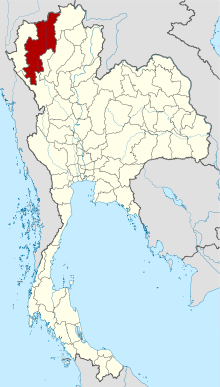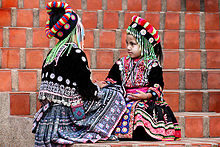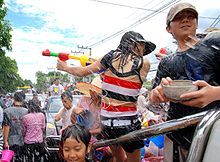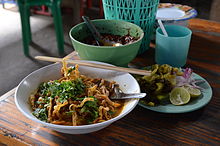- Chiang Mai Province
-
Chiang Mai
เชียงใหม่— Province — 
SealMap of Thailand highlighting Chiang Mai Province Country  Thailand
ThailandCapital Chiang Mai Government - Governor Mom Luang Panutda Ditssakul (since October 2010) - President of the Provincial Administration Organization Boonlert Buranupakorn (since 2008) Area - Total 20,107.0 km2 (7,763.4 sq mi) Area rank Ranked 2nd Population (2005) - Total 1,649,457 - Rank Ranked 6th - Density 82.03/km2 (212.5/sq mi) - Density rank Ranked 58th Time zone Thailand Standard Time (UTC+7) ISO 3166 code TH-50 Chiang Mai (Thai
 เชียงใหม่ (help·info)) is the second-largest province (changwat) of Thailand, located in the north of the country. Neighboring provinces are (from northeast clockwise) Chiang Rai, Lampang, Lamphun, Tak, and Mae Hong Son. In the north it borders Shan State of Burma. Chiang Mai recently started to position itself as a Creative City (Chiang Mai Creative City[1]) and is considering to apply to become a UNESCO Creative City.[2]
เชียงใหม่ (help·info)) is the second-largest province (changwat) of Thailand, located in the north of the country. Neighboring provinces are (from northeast clockwise) Chiang Rai, Lampang, Lamphun, Tak, and Mae Hong Son. In the north it borders Shan State of Burma. Chiang Mai recently started to position itself as a Creative City (Chiang Mai Creative City[1]) and is considering to apply to become a UNESCO Creative City.[2]Contents
Geography
Chiang Mai province is about 700 km from Bangkok and is situated on the Mae Ping River basin and is 300 m above sea level. Surrounded by high mountain ranges, it covers an area of approximately 20,107 km². The district is covered by many mountains, chiefly stretching in the south-north direction. The river Ping, one of the major tributaries of the Chao Phraya River, originates in the Chiang Dao mountains. The highest mountain of Thailand, the 2,565 meter high Doi Inthanon, is located in the province. Several national parks are in the district: Doi Inthanon, Doi Suthep-Pui, Mae Ping, Sri Lanna, Huay Nam Dang, Mae Phang, Chiang Dao.
The mountainous terrain is mainly jungle, parts of which are within national parks which are still fertile and verdant with plentiful flora and fauna. There are many sites and locations where tourists prefer to visit to study the lifestyle of the tribal people who live on high hills.
History
The city of Chiang Mai was capital of the Lanna Kingdom after its founding in 1296. During the same period of time as the establishment of the Sukhothai Kingdom. From then, Chiang Mai not only became the capital and cultural core of the Lanna Kingdom, it was also the centre of Buddhism in northern Thailand and King Meng Rai built innumerable temples.
In 1599 the kingdom lost its independence and became part of the Ayutthaya Kingdom. This ending the dynasty founded by King Meng Rai which had lasted for 300 years. The occupiers Burma, had a powerful Burmese influence on the architecture which can still be seen today. It was only in the late 18th century that Burma was finally defeated with the leadership of King Taksin.
In 1932 the province Chiang Mai became the second level subdivision of Thailand when the administrative unit of Monthon Phayap, the remains of the Lanna Kingdom, was dissolved.
Demographics
13.4% of the population on the province are members of the hill tribes, among them the Hmong, Yao, Lahu, Lisu, Akha and Karen.
Symbols
The seal of the province shows a white elephant in a glass pavilion. The white elephant is a royal symbol in Thailand, and it is depicted to remember the offering of a white elephant by King Rama II to the ruler of Chiang Mai. The pavilion symbolizes that Buddhism prospered in Chiang Mai, especially when in 1477 the teachings of Buddha, the Tripitaka, were reviewed.
The provincial flower and tree is the Flame of the Forest (Butea monosperma). The provincial slogan is In the shadow of Doi Suthep mount, blessed with rice customs and traditions, beautiful wild flowers, magnificent Nakhon Phing.
Administrative divisions
Chiang Mai is subdivided into 25 districts (Amphoe). The districts are further subdivided into 204 subdistricts (Tambon) and 1915 villages (Muban).
- Mueang Chiang Mai
- Chom Thong
- Mae Chaem
- Chiang Dao
- Doi Saket
- Mae Taeng
- Mae Rim
- Samoeng
- Fang
- Mae Ai
- Phrao
- San Pa Tong
- San Kamphaeng
Climate
From November to February during the cool season, Chiang Mai province experiences pleasantly mild sunny weather with temperatures in the city area on average ranging between 15 Celsius at night and around 28 Celsius in daytime. At higher elevations, temperatures can sometimes dip down to freezing point at night. It doesn't snow, but sleet does occur at times.
During the hot season, lasting from March to May, temperatures especially in the city are high, rising into the high 30s.
The rainy season in the north is from June to October.
Transportation
Car Chiang Mai is on Highway 11 (super highway Rd.). Cars can be hired in the provincial capital.
Train Chiang Mai is the terminal station on the northern railway route.
Songthaew Songthaews (passenger pick-up vehicles) are a common mode of transport in both rural and urban areas.
Samlor Samlors (rickshaws) can be found in the main areas.
Tuk-tuk Tuk-tuks are popular with both locals and tourists for short distances.
Bus service Chiang Mai is easily accessible by a multitude of air-conditioned and non air-conditioned buses from Bangkok and all other northern provincial capitals. For travel within the province itself there are older non air-conditioned buses.
Bicycle & Motorbike Both forms of transport can be hired in the provincial capital.
Air Chiang Mai International Airport (CNX) is one of the seven international airports under the responsibility of the Airports of Thailand Public Company Limited (AOT). As Chiang Mai International Airport is the major gateway to the scenic beauty and rich culture of northern Thailand, it plays an important role in promoting travel and tourism throughout the northern region. Today, 14 airlines service the airport and more than 3,000,000 passengers, 15,000 flights and 16,000 tons of cargo are handled at this airport.
Tourism
Chiang Mai province for years now has been the tourist hub of the north and one of Thailand's most important tourist destinations. .[citation needed]It is considered one of the most scenic provinces in the country due to its mountain ranges, valleys, flora and fauna. Unlike most of Thailand, the climate in the north and especially Chiang Mai is cool, fresh and misty.
Attractions
Doi Suthep-Doi Pui National Park (อุทยานแห่งชาติดอยสุเทพ-ปุย) The park consists of forests and mountain ranges. Major mountains include Doi Suthep, Doi Buak Ha, and Doi Pui. This is a main source of tributaries and streams in Chiang Mai. Sacred places, religious attractions and historical sites are located in the park complex.
Walking Street Chiang Mai municipality has organized, since 2006, the Chiang Mai Sunday Evening Walking Street at the Three Kings Monument Courtyard. It has turned into a thriving Sunday evening market which now encompasses nearly the whole of Rachadamnoen road (the main road of the old city), many of its side streets and the square in front of Thapae gate. It is renowned for the locally made handicrafts. In addition, Chiang Mai also organises a Saturday Evening Walking Street on Woa Lai road which runs from Chiang Mai gate, on the south side of the old city, towards the airport.
Chiang Mai Zoo (สวนสัตว์เชียงใหม่) is located next to Huai Kaeo Arboretum. It is a large zoo, which occupies the lower forested slopes of Doi Suthep Mountain. The zoo contains more than 200 types of Asian and African mammals and birds.
Doi Inthanon National Park (อุทยานแห่งชาติดอยอินทนนท์): at 2,565 m, Doi Inthanon is Thailand's highest mountain and one of the coolest peaks. Besides the actual mountain itself, there are a variety of other attractive locations such as Mae Ya, Wachirathan and Siriphum waterfalls and Bori Chinda Cave.
Pang Chang Mae Sa: The elephant shows are a demonstration of the elephants' abilities in log-hauling. After the end of the performance, visitors are able to have a go at riding an elephant.
Wat Phra Singh (วัดพระสิงห์วรวิหาร), houses the revered Phra Phuttha Sihing Buddha (พระพุทธสิหิงค์) image cast in Subduing Mara. The Buddha image is now enshrined in Viharn Lai Kham. The temple compound includes the lovely Viharn Lai Kham featuring exquisite woodcarvings and northern-style murals paintings, a magnificent scriptural repository with striking bas relief, and a circular stupa (in Lankan bell shape).
Mae Sa Waterfall (น้ำตกแม่สา) The famous 8-tiered waterfall in Amphoe Mae Rim occupies a natural setting among towering trees, covered with a lovely breeze all year round.
Night Bazaar: Every evening the center of the provincial city holds one of the provinces biggest markets, selling a huge variety of goods to tourists, both foreign and Thai. The market is 3 blocks long and is surrounded by restaurants, cafes and travel agents.
Chiang Mai Night Safari: The world's third nocturnal zoo and is a government nature theme park which is built to promote Chiang Mai tourism regarding to the government's policy apart from arts, cultures, traditions, and the beauty of nature which are the main fascinating tourist attractions.
Entertainment/Activities
The city of Chiang Mai has a wide variety of activities.
Elephant Show The show begins with elephants bathing to cool themselves then mahouts would place a log harness on their backs. Finally, elephants will demonstrate their forestry skills. Elephant riding and rafting are the most popular activities. Some of the Elephant training centers are:
- Pang Chang Mae Taeng (ปางช้างแม่แตง)
- Chiang Dao Elephant Training Centre (ศูนย์ฝึกช้างเชียงดาว)
- Pang Chang Mae Sa (ปางช้างแม่สา)
- Pang Chang Pong Yaeng (ปางช้างโป่งแยง)
Mountain Biking Mountain biking is done on several routes in Chiang Mai including around the old city moats.
Homestay at Ban Mae Kampong The village is situated in a mountainous area with jungle surroundings. Nearby attractions include waterfalls, a cotton weaving village and the Huai Hong Khrai Royal Agricultural Station.
Hilltribes Trekking Of particular interest to most are the six major hilltribes which inhabit the Northern Highlands. The largest group is Karen, followed by the Meo, Lahu, Yao, Akha and Lisu. They share animism beliefs and honour numerous forest and guardian spirits. Each tribe has distinctive ceremonial attire, courtship rituals, games, dances, agricultural customs, languages or dialects, aesthetic values and hygienic habits.
Bamboo Rafting-Whitewater Rafting Bamboo Rafting along the Mae Taeng River (ล่องแพลำน้ำแม่แตง) is very popular because the river zigzags along the valleys. The river tide is not too rough and the surroundings on both sides are admirable.
Cruising along the Ping River Maenam Ping is the main river in Chiang Mai. While cruising, people can witness the atmosphere of Chiang Mai, as well as the local lifestyle on both sides of the Ping River.
Artificial Rock Climbing Artificial Rock Climbing (ไต่หน้าผาจำลอง) can be practised at the Peak Rock Climbing Plaza.
Golf Courses Due to the pleasant natural surroundings and climate, Chiang Mai is popular for playing golf. There are many courses in the province.
Spa Spa treatment in Chiang Mai includes both traditional remedies and healing arts alongside modern techniques. This treatment, in terms of service available, has escalated over the past few years and there are now innumerable locations offering spa service – often including a Jacuzzi and steam bath.
Shopping Shopping in Chiang Mai is one of the most popular activities of the region. Besides the usual abundance of shopping malls and department stores, there is a huge variety of local markets. The Night Bazaar in downtown Chiang Mai is the most popular location for shopping.
Local Products
Chiang Mai is the center of handicrafts with a variety of antiques, silver jewellery, and embroidery, Thai silks and cottons, basketry, celadon, silverware, furniture, lacquerware, woodcarvings and parasols. Major Chiang Mai products include:
- Cottons & Silks
- Umbrellas/ Parasols - These are inextricably associated with Bo Sang where villagers have been engaged in their manufacture for at least 200 years. All materials, silks, cottons, Sa paper (manufactured from the bark of the mulberry tree) and bamboo are produced or found locally.
- Silverware - Traditional skills and a guaranteed content of at least 92.5% pure silver invest bowls, receptacles and decorative items.
- Lacquerware - This decorative are enhanced items made of wood, bamboo, metal, paper and baked clay, in the form of receptacles, ornaments and various souvenirs.
- Furniture/ Woodcarving - Major woods and materials include teak, rosewood and rattan. Items may be unadorned or, especially with teak and rosewood, carved in traditional or modern designs. Woodcarving is a traditional northern Thai art featured in numerous temples. In recent years, woodcarving has increasingly embellished furniture, gracing screens, chairs, tables, beds, figurines, carved elephant indeed anything bearing a wooden surface large enough to be carved.
- Hilltribe Products - These include silver ornaments, such as bracelets, necklace, pendants and pipes of intricate design, and embroidered items including tunics, jackets, bags, purses, caps and dress lengths.
- Gold Plated Orchids & Butterflies - Orchids and butterflies are preserved and plated with 24-carat gold to create unusual gift items such as necklace pendants, hairpins and earrings.
- Pottery - Chiang Mai is the major centre of Thailand's pottery industry. Prized items include high-fired celadon which is produced in many forms, including dinner sets, lamp bases and decorative items.
- Sa (Mulberry) Paper Products: Chiang Mai is also famous for its Sa paper products a handmade, multi-purpose natural fiber. Sa products that come in different, distinctive designs include cards, notebooks, stationery, boxes, bags, photo frames, lanterns, gift wrapping paper, etc.
Nightlife
For those who love nothing more than a decent night on the town, then Chiang Mai has one of the land's funkiest nightlife.[citation needed] Types of nightlife available include:
- Discos are popular with the younger trendier crowd..[citation needed]
- Live music pubs/restaurants playing either Thai folk music and/or international pop classics.[citation needed]
- Karaoke clubs can be found all around..[citation needed]
- Barbecues are large open-air restaurants which play music and serve alcohol..[citation needed]
- "Bar Beers" are popular with foreign male tourists..[citation needed]
- Thai Pubs are not like Western ones, they are usually huge..[citation needed]
- Western pubs serving draft beer.[citation needed]
Local Culture
The north of Thailand's culture is Lanna in origin and the people are very proud of their northern roots. The region is home to distinctly different food, music, arts, way of life and even language. Chiang Mai is also a melting pot of hill tribes and their own unique cultures.
Traditional lifestyle of the hilltribes
Tai Yai, Burmese in origin, harvest rice, farm, raise cattle and trade. Their craftsmanship lies in weaving, pottery, wood carving and bronzeware.
Akha have the largest population of any hill tribe in the region. Originating from Tibet and Southern China, they dwell on high grounds around 1,200 meters above sea-level. Within their villages they build a Spirit Gateway to protect them from evil spirits.
Lahu are also from Southern China and live in high areas. They are known as hunters and planters.
Karen live in various areas of the region which have valleys and riverbanks.
Hmong from southern China are located on high land. They raise livestock and grow rice, corn, tobacco and cabbage. They are also known for their embroidery and silver.
Tai Lue live in dwellings of usually only a single room wooden house built on high poles. They are skilled in weaving.
Lisu from southern China and Tibet are renowned for their colorful dress and also build their dwellings on high poles. They harvest rice and corn and their men are skilled in hunting.
Yao reside along mountain sides and grow corn and other crops. They are skilled blacksmiths, silversmiths and embroiders.
Events and Festivals
Bo Sang Umbrella Festival (งานเทศกาลร่มบ่อสร้าง) is held in January at Bo Sang Handicraft Centre. The festival features paper products, paper parasols in particular, cultural shows, a parade showing traditional ways of life, and several contests.
Flower Festival (งานมหกรรมไม้ดอกไม้ประดับ) is held in February. The festival includes ornamental garden flower contests, floral floats parade in the morning and beauty pageants. The parade begins at Chiang Mai Railway Station and passes Nawarat Bridge and ends at Nong Buak Hat Park.
Songkran Festival (งานประเพณีสงกรานต์) is held annually from 13 to 15 April. The 13th of April is the Great Songkran day featuring the revered Phra Phuttha Sihing (พระพุทธสิหิงค์) Buddha image parade around Chiang Mai town for bathing, sand pagoda forming, blessing of elders, and water splashing.
Doi Suthep Pilgrimage (งานประเพณีเดินขึ้นดอยสุเทพ) On the night of Visakha Bucha Day, worshippers gather to light candles and make the 7-kilometre pilgrimage up to the temple on Doi Suthep.
City Pillar Inthakin Festival (งานบูชาเสาอินทขิล) is held to invoke blessings of peace, happiness and prosperity for the city and its residents. Buddha images are paraded around the city. It is held at Wat Chedi Luang for 7 auspicious days and nights in the 7th lunar month.
Yi Peng Festival (งานประเพณียี่เป็ง) is held annually on Loy Krathong day (วันลอยกระทง). The festival features the release of lanterns into the sky to worship the gods. There are also fireworks, lantern contests, and beauty pageants.
Art
Chiang Mai province is known as one of the world's top centers for the cottage industry. The area is popular for traditional handicrafts made by craftsmen using skills which have been down through countless generations. They include: silverware, lacquerware, celadon pottery, silk and cotton, hand-painted paper umbrellas and more.
Local Food
- Nam phrik ong is a type of Nam phrik chili paste which is made of minced pork and tomatoes. It is usually eaten with soft-boiled vegetables, pork crackling or deep-fried crunchy rice cakes.
- Nam phrik num meaning in English Chili Paste Young Man, is another kind of paste that is extremely popular in the north and eaten also by Thais of all regions. It is often eaten with pork crackling.
- Sai Ua is a local Chiang Mai sausage that is very aromatic and spicy and is usually eaten with sticky rice.
- Kaeng meaning curries are not made of coconut milk in the north.
- Kaeng Hang-Le is northern-style pork curry
- Kaeng Om is a spicy curry consisting of intestines
- Kaeng Khae is a spicy curry consisting of vegetables.
- Khanom Chin Nam Ngiao is a traditional noodle dish of the North with chicken or pork.
- Khao Soi is another popular noodle dish which can be made from chicken, pork or beef. What makes it unique is that it contains coconut milk and it is garnished with chopped fresh shallots, pickled cabbage, chilli paste to taste and a slice of fresh lime.
Learn
Visitors to Chiang Mai have the opportunity to learn a variety of different Thai-style activities. These activities include Muay Thai (Thai Boxing), Thai cooking, Thai massage and Vipassana Meditation.
Retirement
There are approximately 5,000 expatriates living in Chiang Mai making it one of the most popular destinations for retirement in Thailand. This is probably due to the cool climate, natural surroundings and lower cost of living. .[citation needed]
Sports
There are two main sport stadiums in Mueang District, 700 Years stadium, and Province stadium. The 700 Years stadium is located on Klongchonpratan road, 7km from Chiang Mai University. There are swimming pool, diving pool, basketball stadium, main stadium, etc. There are 11 tennis courts (hard court).
Media/Contact
Nationwide Television, cable TV and local cable TV channels are available in Chiang Mai. Local and nationwide English newspapers and magazines are usually found in book stores.
Landline telephone system, high-speed internet (ADSL), all mobile phone systems, post offices, parcel services are available in Chiang Mai.
Sister cities
 Shanghai, China (2000)
Shanghai, China (2000) Yogyakarta, Indonesia (2007)
Yogyakarta, Indonesia (2007) Busan, South Korea (2009)
Busan, South Korea (2009) Pyongyang, North Korea (2009)
Pyongyang, North Korea (2009) Hue, Vietnam (2009)
Hue, Vietnam (2009) Phnom Penh, Cambodia (2009)
Phnom Penh, Cambodia (2009)
Gallery
-
Lahu farmers in the mountains of Amphoe Omkoi
-
The river going through the town of Mae Chaem
-
Pine forests along road 108 in the mountains near Omkoi
References
- ^ Website of the Chiang Mai Creative City Development Committee. www.creativechiangmai.com
- ^ http://portal.unesco.org/culture/en/ev.php-URL_ID=35257&URL_DO=DO_TOPIC&URL_SECTION=201.html
- ^ The code 25 was assigned to a planned district Wiang Kham, which however wasn't created.
External links
- Chiang Mai Creative City Page
- Province page from the Tourist Authority of Thailand
- Website of Chiang Mai provincial administration
- Website of Chiang Mai Provincial Administration Organization

Shan State,  Myanmar
MyanmarChiang Rai Province 
Mae Hong Son Province 
Lampang Province  Chiang Mai Province
Chiang Mai Province 

Tak Province Lamphun Province Provinces of Thailand Capital: Bangkok North North-East Amnat Charoen · Bueng Kan · Buri Ram · Chaiyaphum · Kalasin · Khon Kaen · Loei · Maha Sarakham · Mukdahan · Nakhon Phanom · Nakhon Ratchasima · Nong Bua Lamphu · Nong Khai · Roi Et · Sakon Nakhon · Sisaket · Surin · Ubon Ratchathani · Udon Thani · YasothonCentral Ang Thong · Chai Nat · Kamphaeng Phet · Lop Buri · Nakhon Nayok · Nakhon Pathom · Nakhon Sawan · Nonthaburi · Pathum Thani · Phetchabun · Phichit · Phitsanulok · Phra Nakhon Si Ayutthaya · Samut Prakan · Samut Sakhon · Samut Songkhram · Saraburi · Sing Buri · Sukhothai · Suphan Buri · Uthai ThaniEast West South Chumphon · Krabi · Nakhon Si Thammarat · Narathiwat · Pattani · Phang Nga · Phatthalung · Phuket · Ranong · Satun · Songkhla · Surat Thani · Trang · YalaCoordinates: 18°50′14″N 98°58′14″E / 18.83722°N 98.97056°E
Categories:
Wikimedia Foundation. 2010.















